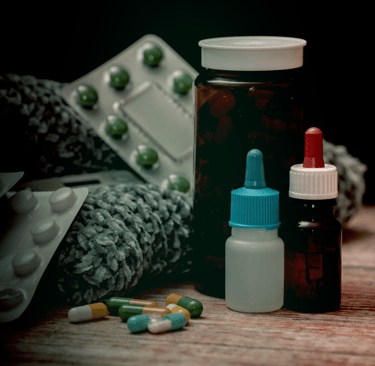Antimicrobial Resistance: The Silent Pandemic That Could Surpass Cancer
Antimicrobial Resistance (AMR) is a silent pandemic that could claim more lives than cancer by 2050. Learn the latest facts about rising superbugs, global efforts to combat antibiotic resistance, and practical steps you can take to protect yourself and future generations. Fight AMR with smart antibiotic use and support innovative solutions like phage therapy.
6/23/20253 min read


Jakarta, Indonesia – June 2025 Edition – While global headlines often pivot to viral outbreaks, an insidious, invisible pandemic is silently gaining ground: Antimicrobial Resistance (AMR) – the alarming phenomenon where bacteria, viruses, fungi, and parasites evolve to defeat the very drugs designed to kill them. Health experts worldwide issue a grim warning: by 2050, if urgent and concerted action isn't taken, AMR could tragically claim more lives annually than cancer.
What’s the Threat? The Rise of "Superbugs"
AMR is a natural evolutionary process accelerated by the overuse and misuse of antimicrobials in human health, animal agriculture, and even the environment. When microorganisms no longer respond to once-effective medicines, common infections become harder, or even impossible, to treat.
The World Health Organization (WHO) starkly states, "We're entering a post-antibiotic era. Infections we once cured with a pill could become fatal again." This isn't just a distant threat; it's already impacting healthcare systems globally.
Key Superbugs on the Rise:
MRSA (methicillin-resistant Staphylococcus aureus): A common cause of skin infections, now often hospital-acquired and highly resistant.
Drug-resistant tuberculosis (TB): Making one of the world's oldest scourges significantly harder to treat.
Carbapenem-resistant Enterobacteriaceae (CRE): Often referred to as "nightmare bacteria" due to their high resistance and fatality rates.
Why It Matters Globally: A Looming Crisis
The implications of unchecked AMR are vast and terrifying:
Healthcare Catastrophe: Routine medical procedures – from hip replacements and organ transplants to cancer chemotherapy and even childbirth – become incredibly risky due to untreatable infections.
Borderless Spread: Drug-resistant infections respect no borders, spreading rapidly across countries and continents through travel and trade.
Economic Burden: AMR could cripple the global economy, potentially costing an estimated $100 trillion by 2050 due to productivity losses, increased healthcare expenditures, and trade disruptions.
Fast Facts: The Human Cost
5 million deaths were directly or indirectly linked to AMR in 2023.
10 million deaths per year are projected by 2050 if current trends continue.
Billions are already being spent yearly on ineffective treatments and prolonged hospital stays due to resistant infections.
What’s Being Done? Fighting Back!
Global efforts are intensifying to combat this silent pandemic, adopting a "One Health" approach that recognizes the interconnectedness of human, animal, and environmental health:
Hospital Antibiotic Stewardship Programs: Promoting the responsible use of antibiotics in healthcare settings to preserve their effectiveness.
Global Surveillance of Superbugs: Enhanced monitoring systems, like WHO's GLASS (Global Antimicrobial Resistance and Use Surveillance System), track resistance patterns to inform strategies. The 2025 global survey (TrACSS) is underway to assess country progress.
Development of New Antimicrobials & Phage Therapy: Researchers are actively discovering new classes of antibiotics (e.g., lariocidin, found by McMaster researchers in March 2025) and exploring alternative treatments like phage therapy (using viruses that specifically target bacteria). Phage therapy is currently in various clinical trials for conditions like UTIs, cystic fibrosis, and burn infections, with conferences like "Targeting Phage Therapy 2025" in Berlin accelerating its clinical integration.
Public Campaigns to Reduce Antibiotic Misuse: Educating the public on responsible antibiotic use is crucial to curb resistance development.
Policy & Investment: International collaborations, such as the Davos Compact on AMR 2025, are mobilizing financial resources from public and private sectors to support innovation and ensure access to effective treatments, aiming to save over 100 million lives by 2050.
What YOU Can Do: Be Part of the Solution
Every individual has a role in slowing AMR:
Don’t demand antibiotics for viral infections like colds or flu. Antibiotics are ineffective against viruses.
Always finish your full antibiotic prescription, even if you feel better. Stopping early can allow resistant bacteria to survive.
Support legislation and initiatives promoting responsible antibiotic use in farming and food production.
Practice good hygiene – regular hand washing helps prevent the spread of infections.
The fight against AMR requires collective action. By understanding the threat and taking personal responsibility, we can all contribute to safeguarding the effectiveness of these life-saving medicines for generations to come.
Keywords: AMR 2025, Antimicrobial Resistance, Superbugs, Drug Resistant Infections, GlobalHealthCrisis, Silent Pandemic, Infectious Disease, Antibiotic Resistance, PhageTherapy, One Health, WHO, Public Health, Health Innovation, Preventive Medicine



